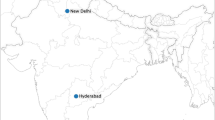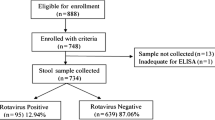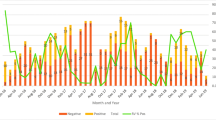Abstract
Objectives
To estimate the proportion of rotavirus diarrhea among hospitalized children aged under-five years, to determine the circulating rotavirus genotypes and to know impact rotavirus vaccine on prevalence and severity of rotavirus diarrhea.
Methods
This study was a hospital based cross-sectional observational study conducted over a period of 29 mo (September 2017 through January 2020). Stool samples were collected from children who fall within the age range of 0–59 mo with acute diarrhea attending emergency or needing admission. Stool samples were tested for rotavirus by the enzyme linked immune-sorbent assay (ELISA) and genotyped using published methods.
Results
Out of 1480 samples, 360 (24.32%) cases were positive for rotavirus by ELISA, majority of them were male (62.97%). Maximum rotavirus positivity was found in the age group of <11 mo (55.27%). Statistically significance difference was seen in episodes of diarrhea and experience of vomiting in rotavirus diarrhea cases. Highest prevalence has been seen during winter season. The most prevalent G and P type combinations were G3P [8] strains [122 (34.08%)], G2P [4] [83 (23.18%)], G1P [8] [27 (7.54%)] and G9P [4] [20 (5.59%)]. Mixed strains contribute a significant proportion of stool sample.
Conclusions
Rotavirus is an important cause of diarrhea in hospitalized children. There is continued circulation of G9 and G12 strains and the emergence of G3P [8] as most common strain.


Similar content being viewed by others
References
Naghavi M, Abajobir AA, Abbafati C, et al. Global, regional, and national age-sex specific mortality for 264 causes of death, 1980–2016: a systematic analysis for the Global Burden of Disease Study 2016. Lancet [Internet]. 2017;390:1151–210 Available at: https://www.thelancet.com/journals/lancet/article/PIIS0140-6736(17)32152-9/abstract. Accessed 6 Oct, 2020.
Bassani DG, Kumar R, Awasthi S, et al; Million Death Study Collaborators. Causes of neonatal and child mortality in India: a nationally representative mortality survey. Lancet. 2010;376:1853–60.
Trends of Communicable Disease & IDSP reporting in Rajasthan- Dr. Monika Rathore.pdf [Internet]. Available at: http://164.100.222.222/content/dam/doitassets/education/medicaleducation/sms-medical-college-jaipur/pdf/Trends%20of%20Communicable%20Disease%20&%20IDSP%20reporting%20in%20Rajasthan-%20Dr.%20Monika%20Rathore.pdf. Accessed 6 Oct, 2020.
Badur S, Öztürk S, Pereira P, et al. Systematic review of the rotavirus infection burden in the WHO-EMRO region. Hum Vaccines Immunotherap [Internet]. 2019. Available at: https://www.tandfonline.com/doi/full/10.1080/21645515.2019.1603984. Accessed 19 Jun 2019.
Babji S, Arumugam R, Sarvanabhavan A, et al. Multi-center surveillance of rotavirus diarrhea in hospitalized children <5 years of age in India, 2009-2012. Vaccine. 2014;32:A10–2.
John J, Sarkar R, Muliyil J, Bhandari N, Bhan MK, Kang G. Rotavirus gastroenteritis in India, 2011-2013: revised estimates of disease burden and potential impact of vaccines. Vaccine. 2014;32:A5–9.
Nair NP, Reddy NS, Giri S, et al. Rotavirus vaccine impact assessment surveillance in India: protocol and methods. BMJ Open [Internet]. 2019;9:e024840 Available at: http://bmjopen.bmj.com/lookup/doi/10.1136/bmjopen-2018-024840. Accessed 13 Aug 2019.
Malik A, Haldar P, Ray A, et al. Introducing rotavirus vaccine in the universal immunization Programme in India: from evidence to policy to implementation. Vaccine [Internet]. 2019;37:5817–24 Available at: http://www.sciencedirect.com/science/article/pii/S0264410X19310254. Accessed 15 Sept 2020.
_download_pub.pdf [Internet]. Available at: https://publications.jsi.com/JSIInternet/Inc/Common/_download_pub.cfm?id=22901&lid=3. Accessed 6 Oct 2020.
Ruuska T, Vesikari T. Rotavirus disease in Finnish children: use of numerical scores for clinical severity of diarrhoeal episodes. Scandinavian J Infect Dis. 1990;22:259–67.
Kang G, Desai R, Arora R, et al. Diversity of circulating rotavirus strains in children hospitalized with diarrhea in India, 2005-2009. Vaccine. 2013;31:2879–83.
Bines JE, Ivanoff B, Justice F, Mulholland K. Clinical case definition for the diagnosis of acute intussusception. J Pediatr Gastroenterol Nutr. 2004;39:511–8.
Ameta P, Nayak VH, Goyal SC. Prevalence and seasonal distribution of rotavirus diarrhea in hospitalized children less than 5 year old in South Rajasthan. Int J Biomed Res [Internet]. 2015;6:214–8. Available at: https://ssjournals.com/index.php/ijbr/article/view/1672. Accessed 6 Oct 2020.
Ari A, Chaudhary R, Sharma SD. Rotavirus diarrhoea among children under five years in a tertiary level government of Rajasthan. J Nepal Paediatr Soc [Internet]. 2016;36:273–6 Available at: https://www.nepjol.info/index.php/JNPS/article/view/15398. Accessed 6 Oct 2020.
Giri S, Nair NP, Mathew A, et al. Rotavirus gastroenteritis in Indian children < 5 years hospitalized for diarrhoea, 2012 to 2016. BMC Public Health [Internet]. 2019;19:69. https://doi.org/10.1186/s12889-019-6406-0.
Dutta SR, Khalfan SA, Baig BH, Philipose L, Fulayfil R. Epidemiology of rotavirus diarrhoea in children under five years in Bahrain. Int J Epidemiol. 1990;19:722–7.
Nath G, Singh SP, Sanyal SC. Childhood diarrhoea due to rotavirus in a community. Indian J Med Res. 1992;95:259–62.
Phukan AC, Patgiri DK, Mahanta J. Rotavirus associated acute diarrhoea in hospitalized children in Dibrugarh, north-east India. Indian J Pathol Microbiol. 2003;46:274–8.
Shrivastava AK, Reddy NS, Giri S, et al. Burden and molecular epidemiology of Rotavirus causing diarrhea among under-five children: a hospital-based study from Eastern India. J Global Infect Dis [Internet]. 2019;11:147 Available at: http://www.jgid.org/article.asp?issn=0974-777X;year=2019;volume=11;issue=4;spage=147;epage=152;aulast=Shrivastava;type=0. Accessed 6 Oct 2020.
Stupka JA, Degiuseppe JI, Parra GI; Argentinean National Rotavirus Surveillance Network. Increased frequency of rotavirus G3P[8] and G12P[8] in Argentina during 2008–2009: whole-genome characterization of emerging G12P[8] strains. J Clin Virol. 2012;54:162–7.
Chitambar SD, Ranshing SS, Pradhan GN, Kalrao VR, Dhongde RK, Bavdekar AR. Changing trends in circulating rotavirus strains in Pune, western India in 2009-2012: emergence of a rare G9P[4] rotavirus strain. Vaccine. 2014;32:A29–32.
Taniguchi K, Urasawa T, Kobayashi N, Gorziglia M, Urasawa S. Nucleotide sequence of VP4 and VP7 genes of human rotaviruses with subgroup I specificity and long RNA pattern: implication for new G serotype specificity. J Virol. 1990;64:5640–4.
Santos N, Hoshino Y. Global distribution of rotavirus serotypes/genotypes and its implication for the development and implementation of an effective rotavirus vaccine. Rev Med Virol. 2005;15:29–56.
Banerjee I, Ramani S, Primrose B, et al. Modification of rotavirus multiplex RT-PCR for the detection of G12 strains based on characterization of emerging G12 rotavirus strains from South India. J Med Virol [Internet]. 2007;79:1413–21 Available at: https://www.ncbi.nlm.nih.gov/pmc/articles/PMC2465801/. Accessed 5 Oct 2020.
Rahman M, Matthijnssens J, Yang X, et al. Evolutionary history and global spread of the emerging g12 human rotaviruses. J Virol. 2007;81:2382–90.
Das S, Varghese V, Chaudhury S, et al. Emergence of novel human group A rotavirus G12 strains in India. J Clin Microbiol [Internet]. 2003;41:2760–2 Available at: https://www.ncbi.nlm.nih.gov/pmc/articles/PMC156500/. Accessed 5 Oct 2020.
Sharma S, Ray P, Gentsch JR, Glass RI, Kalra V, Bhan MK. Emergence of G12 rotavirus strains in Delhi, India, in 2000 to 2007. J Clin Microbiol. 2008;46:1343–8.
Mukherjee A, Chattopadhyay S, Bagchi P, et al. Surveillance and molecular characterization of rotavirus strains circulating in Manipur, North-Eastern India: increasing prevalence of emerging G12 strains. Infect Genet Evolution: J Mol Epidemiol Evolutionary Genet Infect Dis. 2010;10:311–20.
Thanh HD, Tran VT, Lim I, Kim W. Emergence of human G2P[4] rotaviruses in the post-vaccination era in South Korea: footprints of multiple interspecies re-assortment events. Scientific Reports [Internet]. 2018;8:6011. Available at: https://www.nature.com/articles/s41598-018-24511-y. Accessed 6 Oct 2020.
Gentsch JR, Laird AR, Bielfelt B, et al. Serotype diversity and reassortment between human and animal rotavirus strains: implications for rotavirus vaccine programs. J Infect Dis. 2005;192:S146–59.
Acknowledgements
The study was supported by the Indian Council of Medical Research, New Delhi; Ministry of Health and Family Welfare, Govt. of India and the State government of the participating institution.
The authors thank the team at Christian Medical College, Vellore for support, and the children and families for participation.
Funding
This work was supported by grants from the Bill and Melinda Gates Foundation to the Centers for Disease Control and Prevention, Atlanta, GA, USA (subcontract to Christian Medical College, Vellore grant no MOA#871-15SC) and the Translational Health Science and Technology Institute (grant no OPP1165083).
Author information
Authors and Affiliations
Contributions
RKG and AKG designed the study. Data collection and management was done by AKG, SV and RA. RKG, AKG, NPN and VT performed the data analysis for the study. RKG and RA did the review of literature. AKG, SV, and RA wrote the manuscript, and it was critically reviewed by RKG and AKG. Final approval of submitted version was done by RKG and AKG. All authors read and approved the final manuscript.
Corresponding author
Ethics declarations
Conflict of Interest
None.
Ethical Clearance
An ethics clearance was obtained from institutional ethics committee. (3205/MC/EC/2017 dated 08.06.2017).
Additional information
Publisher’s Note
Springer Nature remains neutral with regard to jurisdictional claims in published maps and institutional affiliations.
Rights and permissions
About this article
Cite this article
Gupta, R.K., Vajpayee, S., Agrawal, R. et al. Post Vaccination Epidemiology and Genotyping of Rotavirus Gastroenteritis at a Tertiary Care Centre of North-East Rajasthan. Indian J Pediatr 88 (Suppl 1), 90–96 (2021). https://doi.org/10.1007/s12098-020-03569-5
Received:
Accepted:
Published:
Issue Date:
DOI: https://doi.org/10.1007/s12098-020-03569-5




